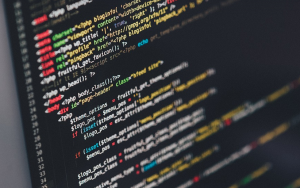
Demystifying the World of Code
Welcome to the exciting world of scripting and programming! Whether you’re a complete beginner or looking to delve deeper into your coding skills, this guide is here to help. We’ll embark on a journey of discovery, exploring key concepts and laying the groundwork for building amazing things with code.
Let’s start by understanding what scripting and programming truly mean. Think of it like having a very specific set of instructions that tell your computer exactly how to perform a task—like automating calculations, manipulating images, or even creating interactive games! You can imagine giving commands to a robot, but instead of physical movements, you use code.
The Building Blocks: Understanding the Basics
At the heart of every program lies a set of fundamental building blocks. These elements provide the language and syntax for expressing your instructions in code. Just like playing a musical instrument requires learning chords and scales, our programming journey starts by mastering these basics:
1. Programming Languages: The Everyday Language of Computers
Imagine you’re explaining a task to someone who doesn’t speak your language. You’d need to use words they understand—right? Programming languages are the same! They allow us to communicate directly with computers, using specialized terms and syntax that they interpret as instructions.
For example, Python is a popular choice for beginners – it uses simple English-like words (like “if,” “then,” and “else”) to instruct the computer. JavaScript, on the other hand, focuses on bringing dynamic elements to websites, making them interactive and engaging.
2. Variables: Storing Information for Later Use
Think of variables as containers holding information your program needs to work with. Each container has a name and can store different types of data like numbers, words, or even complex formulas. They’re essential for organizing your code and making it reusable.
For example, you might use a variable called “total” to represent the sum of all student scores in a class. This allows you to easily calculate the average later.
3. Operators: Performing Actions with Data
Operators are like handy tools that allow us to perform various actions on our data. Think of these as symbols that tell your computer what to do with its stored information; for example, addition, subtraction, multiplication, and division.
For instance, you might use the “+” operator to add two numbers in a program or the “-” operator to subtract. The “+” and “-” symbols tell your program what action to take with the numbers it receives as input.
D278: A Foundation for Success
D278 is an important framework that helps you understand how to write code effectively, building a solid foundation for future learning. It’s like a map guiding your journey through programming, offering insights and techniques that will make your coding adventures smoother. Here’s why it’s worth exploring:
1. Syntax: The Structure of Code
Syntax is the set of rules that dictate how to structure your code for optimal readability and understanding. It’s like a grammar guide for programming, ensuring your instructions are clear, concise, and easily understood by both humans and computers.
For example, in Python, indentation is crucial! Every line within a block of code needs to be placed at the correct level to follow the script’s structure. This ensures that your computer knows which part of the program to execute when you run it.
2. Logic: Making Decisions and Taking Action
Think of logic like a puzzle where you need to figure out the best way to solve a problem! Logic is at the heart of what makes programming so dynamic. It allows us to write code that can make decisions, follow specific rules, and even react to changing conditions.
For example, imagine you’re writing a program to control a traffic light. You could use logic to implement “if-then-else” statements – essentially creating a chain of checks to determine when the lights turn red, yellow, or green. This allows your program to adapt and make informed decisions based on specific conditions.
3. Data Structures: Organizing Information
Data structures are ways we organize information so it becomes easily accessible. Like organizing a box of tools for easier access, these structures help keep our code neat and manageable! They provide efficient storage and retrieval methods for data, ensuring your program runs smoothly.
For instance, lists allow us to store a collection of items in an ordered sequence. This is perfect for storing shopping lists or inventory details. Arrays offer a similar approach but allow you to access elements by their position within the list – much like having specific slots in a box.
4. Libraries: Pre-built Solutions
Imagine building a house without any prefabricated materials! It’s incredibly time-consuming and laborious. Similarly, programming can be daunting without readily available solutions. Fortunately, software libraries offer pre-written code for common tasks. Like ready-made cabinet boxes or shelves that help organize your home, they empower you to create projects faster.
For example, there’s a library called “NumPy” in Python, which provides tools for performing complex mathematical calculations – saving you from writing the whole process from scratch. It’s basically pre-built mathematical blocks that can be easily incorporated into your programs.
Embark on Your Coding Journey
As you move forward, remember this: programming is a journey of continuous learning and exploration! Don’t hesitate to ask questions, try new things, experiment with code, and never stop making your programs more creative and engaging.
Remember, the most important thing about coding is to have fun while you learn. Programming is like painting a masterpiece; it’s about using creativity and logic to build something beautiful and functional!


